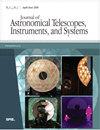SALTUS probe class space mission: observatory architecture and mission design
IF 3.1
3区 工程技术
Q2 ENGINEERING, AEROSPACE
Journal of Astronomical Telescopes Instruments and Systems
Pub Date : 2024-08-01
DOI:10.1117/1.jatis.10.4.042303
引用次数: 0
Abstract
We describe the space observatory architecture and mission design of the Single Aperture Large Telescope for Universe Studies (SALTUS) mission, a National Aeronautics and Space Administration (NASA) Astrophysics Probe Explorer concept. SALTUS will address key far-infrared science using a 14-m diameter <45 K primary reflector (M1) and will provide unprecedented levels of spectral sensitivity for planet, solar system, and galactic evolution studies and cosmic origins. Drawing from Northrop Grumman’s extensive NASA mission heritage, the observatory flight system is based on the LEOStar-3 spacecraft platform to carry the SALTUS Payload. The Payload is comprised of the inflation control system, sunshield module (SM), cold corrector module (CCM), warm instrument electronics module, and primary reflector module (PRM). The 14-m M1 is an off-axis inflatable membrane radiatively cooled by a two-layer sunshield (∼1000 m2 per layer). The CCM corrects for residual aberration from M1 and delivers a focused beam to two instruments—the High-Resolution Receiver (HiRX) and SAFARI-Lite. The CCM and PRM reside atop a truss-based composite deck that also provides a platform for the attitude control system. The SALTUS 5-year mission lifetime is driven by a two-consumable architecture: the propellant system and the inflation control system. The core interface module (CIM), a multi-faceted composite truss structure, provides a load path with high stiffness, mechanical attachment, and thermal separation between the Payload and spacecraft. The SM attaches outside the CIM with its aft end integrating directly to the bus. The spacecraft maintains an attitude off M1’s boresight with respect to the Sun line to facilitate the <45 K thermal environment. SALTUS will reside in a Sun–Earth halo L2 orbit with a maximum Earth slant range of 1.8 million km, thereby reducing orbit transfer delta-v. The instantaneous field of regard provides two continuous 20 deg viewing zones around the ecliptic poles, resulting in full sky coverage in 6 months.SALTUS 探测器级空间飞行任务:观测站结构和飞行任务设计
我们介绍了单孔大型宇宙研究望远镜(SALTUS)任务的空间观测站结构和任务设计,这是美国国家航空航天局(NASA)的天体物理学探测器概念。SALTUS 将使用一个 14 米直径 <45 K 的主反射镜(M1)来解决关键的远红外科学问题,并将为行星、太阳系和银河系演化研究以及宇宙起源提供前所未有的光谱灵敏度。借鉴诺斯罗普-格鲁曼公司在 NASA 任务中的丰富经验,天文台飞行系统以 LEOStar-3 航天器平台为基础,搭载 SALTUS 有效载荷。有效载荷由充气控制系统、遮阳板模块(SM)、冷校正器模块(CCM)、热仪器电子模块和主反射器模块(PRM)组成。14 米长的 M1 是一个离轴充气膜,由两层遮阳板(每层 1000 平方米)辐射冷却。CCM 校正来自 M1 的残余像差,并向两台仪器--高分辨率接收器(HiRX)和 SAFARI-Lite 发射聚焦光束。CCM 和 PRM 位于桁架式复合材料甲板之上,该甲板也为姿态控制系统提供了一个平台。SALTUS 5 年任务寿命由两个可消耗结构驱动:推进剂系统和充气控制系统。核心接口模块(CIM)是一个多面复合材料桁架结构,在有效载荷和航天器之间提供了一个具有高刚度、机械连接和热分离的负载路径。SM 安装在 CIM 外,其尾端直接与总线相连。航天器相对于太阳线保持偏离 M1 内径的姿态,以促进 <45 K 的热环境。SALTUS 将位于日地晕 L2 轨道上,最大地球斜距为 180 万公里,从而减少了轨道转移 delta-v。瞬时视场围绕黄道两极提供两个连续的 20 度观测区,从而在 6 个月内覆盖整个天空。
本文章由计算机程序翻译,如有差异,请以英文原文为准。
求助全文
约1分钟内获得全文
求助全文
来源期刊

Journal of Astronomical Telescopes Instruments and Systems
Engineering-Mechanical Engineering
CiteScore
4.40
自引率
13.00%
发文量
119
期刊介绍:
The Journal of Astronomical Telescopes, Instruments, and Systems publishes peer-reviewed papers reporting on original research in the development, testing, and application of telescopes, instrumentation, techniques, and systems for ground- and space-based astronomy.
 求助内容:
求助内容: 应助结果提醒方式:
应助结果提醒方式:


